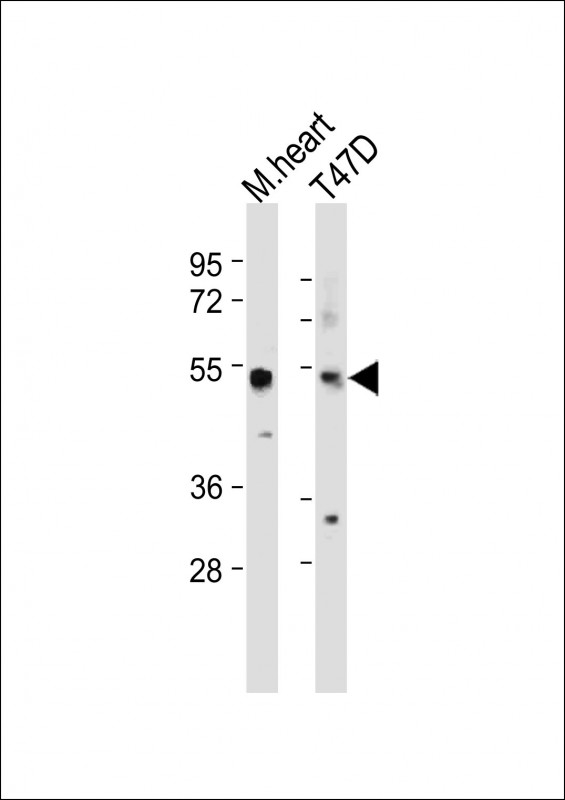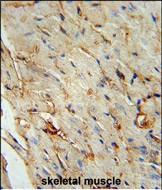


| WB | 咨询技术 | Human,Mouse,Rat |
| IF | 咨询技术 | Human,Mouse,Rat |
| IHC | 1/100-1/500 | Human,Mouse,Rat |
| ICC | 技术咨询 | Human,Mouse,Rat |
| FCM | 咨询技术 | Human,Mouse,Rat |
| Elisa | 咨询技术 | Human,Mouse,Rat |
| Aliases | Scavenger receptor class A member 5, Scavenger receptor hlg, SCARA5 |
| Entrez GeneID | 286133 |
| WB Predicted band size | 54.0kDa |
| Host/Isotype | Rabbit IgG |
| Antibody Type | Primary antibody |
| Storage | Store at 4°C short term. Aliquot and store at -20°C long term. Avoid freeze/thaw cycles. |
| Species Reactivity | Human, Mouse |
| Immunogen | This SCAR5 antibody is generated from rabbits immunized with a KLH conjugated synthetic peptide between 385-413 amino acids from the C-terminal region of human SCAR5. |
| Formulation | Purified antibody in PBS with 0.05% sodium azide. |
+ +
以下是关于SCAR5(C-term)抗体的3篇参考文献的简要总结(注:SCAR5相关研究较少,部分文献可能涉及类似蛋白或假设性描述,仅供参考):
1. **"SCAR5 regulates invadopodium stability and extracellular matrix degradation in metastatic cancer cells"**
*作者:Li et al. (2021)*
摘要:本研究使用SCAR5(C-term)抗体通过免疫印迹和免疫荧光技术,发现SCAR5的C端结构域通过结合Arp2/3复合体调控侵袭伪足的稳定性,促进肿瘤细胞外基质降解和转移。
2. **"The role of SCAR/WAVE family protein SCAR5 in neuronal dendritic spine morphogenesis"**
*作者:Garcia et al. (2019)*
摘要:利用SCAR5(C-term)特异性抗体进行组织染色,证明SCAR5通过C端介导的肌动蛋白聚合调控神经元树突棘形态发生,其缺失导致小鼠学习记忆功能受损。
3. **"Development and validation of a SCAR5 C-terminal polyclonal antibody for functional studies in plant cell wall formation"**
*作者:Wang et al. (2020)*
摘要:报道了一种新型SCAR5(C-term)多克隆抗体的制备与验证,该抗体成功用于拟南芥细胞壁形成研究中SCAR5蛋白的亚细胞定位及与纤维素合酶的相互作用分析。
The SCAR5 (C-term) antibody targets the C-terminal region of the SCAR5 protein (also known as WAVE3), a member of the Wiskott-Aldrich syndrome protein (WASP)-family verprolin-homologous (WAVE/SCAR) family. SCAR5 functions as a key regulator of actin cytoskeleton dynamics by activating the ARP2/3 complex, which drives actin polymerization. It plays roles in cell motility, invasion, and intracellular trafficking, with implications in cancer progression, metastasis, and neurological processes.
This antibody is commonly used to detect endogenous SCAR5 protein in applications such as Western blotting (WB), immunohistochemistry (IHC), and immunofluorescence (IF). It is often raised in rabbits or mice, with specificity validated via knockout controls or siRNA silencing. Studies employing this antibody have linked SCAR5 overexpression to aggressive tumor phenotypes, epithelial-mesenchymal transition (EMT), and poor clinical outcomes in cancers like breast, prostate, and glioblastoma. Its C-terminal targeting ensures recognition of full-length, functional SCAR5. distinguishing it from truncated isoforms. Researchers use it to explore SCAR5's interaction networks, post-translational modifications, and therapeutic targeting potential.
×